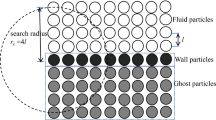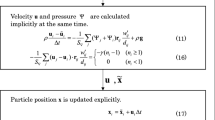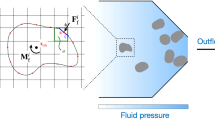Abstract
Accurately resolving the coupled momentum transfer between the liquid and solid phases of complex fluids is a fundamental problem in multiphase transport processes, such as hydraulic fracture operations. Specifically we need to characterize the dependence of the normalized average fluid–particle force \(\langle F \rangle\) on the volume fraction of the dispersed solid phase and on the rheology of the complex fluid matrix, parameterized through the Weissenberg number Wi measuring the relative magnitude of elastic to viscous stresses in the fluid. Here we use direct numerical simulations (DNS) to study the creeping flow (\(Re\ll 1\)) of viscoelastic fluids through static random arrays of monodisperse spherical particles using a finite volume Navier–Stokes/Cauchy momentum solver. The numerical study consists of \(N=150\) different systems, in which the normalized average fluid–particle force \(\langle F \rangle\) is obtained as a function of the volume fraction \(\phi\) \((0 < \phi \le 0.2)\) of the dispersed solid phase and the Weissenberg number Wi \((0 \le Wi \le 4)\). From these predictions a closure law \(\langle F(\phi,Wi) \rangle\) for the drag force is derived for the quasi-linear Oldroyd-B viscoelastic fluid model (with fixed retardation ratio \(\beta = 0.5\)) which is, on average, within \(5.7\%\) of the DNS results. In addition, a flow solver able to couple Eulerian and Lagrangian phases (in which the particulate phase is modeled by the discrete particle method (DPM)) is developed, which incorporates the viscoelastic nature of the continuum phase and the closed-form drag law. Two case studies were simulated using this solver, to assess the accuracy and robustness of the newly developed approach for handling particle-laden viscoelastic flow configurations with \(O(10^5-10^6)\) rigid spheres that are representative of hydraulic fracture operations. Three-dimensional settling processes in a Newtonian fluid and in a quasi-linear Oldroyd-B viscoelastic fluid are both investigated using a rectangular channel and an annular pipe domain. Good agreement is obtained for the particle distribution measured in a Newtonian fluid, when comparing numerical results with experimental data. For the cases in which the continuous fluid phase is viscoelastic we compute the evolution in the velocity fields and predicted particle distributions are presented at different elasticity numbers \(0\le El \le 30\) (where \(El=Wi/Re\)) and for different suspension particle volume fractions.

















Similar content being viewed by others
References
Liff SM, Kumar N, McKinley GH (2007) High-performance elastomeric nanocomposites via solvent-exchange processing. Nat Materials 6:76–83. https://doi.org/10.1038/nmat1798
Olsen T, Helal A, McKinley GH, Kamrin K (2016) Coupled dynamics of flow, microstructure, and conductivity in sheared suspensions. Soft Matter 12:7688–7697. https://doi.org/10.1039/C6SM01199C
Lim EJ, Ober TJ, Edd JF, Desai SP, Neal D, Bong KW, Doyle PS, McKinley GH, Toner M (2014) Inertio-elastic focusing of bioparticles in microchannels at high throughput. Nat Commun 5:1–9. https://doi.org/10.1038/ncomms5120
Parmigiani A, Faroughi SA, Huber C, Bachmann O, Su Y (2016) Bubble accumulation and its role in the evolution of magma reservoirs in the upper crust. Nature 532:492–495. https://doi.org/10.1038/nature17401
Barbati AC, Desroches J, Robisson A, McKinley GH (2016) Complex fluids and hydraulic fracturing. Ann Rev Chem Biomol Eng 7:415–453. https://doi.org/10.1146/annurev-chembioeng-080615-033630
Faroughi SA, Pruvot A, Jean-Claude J, McAndrew J (2018) The rheological behavior of energized fluids and foams with application to hydraulic fracturing. J Petroleum Sci Eng 163:243–263. https://doi.org/10.1016/j.petrol.2017.12.051
Faroughi SA, Huber C (2015) Unifying the relative hindered velocity in suspensions and emulsions of nondeformable particles. Geophys Res Lett 42:53–59. https://doi.org/10.1002/2014GL062570
Faroughi SA, Huber C (2016) A theoretical hydrodynamic modification on the soil texture analyses obtained from the hydrometer test. Géotechnique 66(5):378–385. https://doi.org/10.1680/jgeot.14.P.267
Shaqfeh ESG (2019) On the rheology of particle suspensions in viscoelastic fluids. AIChE J 65:1–10. https://doi.org/10.1002/aic.16575
Tanner RI (2019) Review: Rheology of noncolloidal suspensions with non-Newtonian matrices. J Rheol 63:705–717. https://doi.org/10.1122/1.5085363
Stokes GG (1851) On the effect of the internal friction of fluids on the motion of pendulums. Trans Camb Phil Soc 9:8–106. https://doi.org/10.1017/CBO9780511702266.002
Happel J, Brenner H (1983) Low Reynolds number hydrodynamics with special applications to particulate media. Springer, Netherlands
Kim S, Karrila SJ (2005) Microhydrodynamics: principles and selected applications. Dover Publications, Mineola
Guazzelli E, Morris J (2011) A physical introduction to suspension dynamics. Cambridge University Press, Cambridge
van der Hoef MA, Beetstra R, Kuipers JAM (2005) Lattice-Boltzmann simulations of low-Reynolds-number flow past mono- and bidisperse arrays of spheres: results for the permeability and drag force. J. Fluid Mech. 528:233–254. https://doi.org/10.1017/S0022112004003295
Hasimoto H (1959) On the periodic fundamental solutions of the Stokes equations and their application to viscous flow past a cubic array of spheres. J Fluid Mech 5:317–328. https://doi.org/10.1017/S0022112059000222
Brinkman HC (1947) A calculation of the viscous force exerted by a flowing fluid on a dense swarm of particles. Appl Sci Res A 1:27–34. https://doi.org/10.1007/BF02120313
Kim S, Russel WB (1985) Modelling of porous media by renormalization of the Stokes equations. J Fluid Mech 154:269–286. https://doi.org/10.1017/S0022112085001525
Carman PC (1937) Fluid flow through granular beds. Trans Inst Chem Eng Lond 15:150–166
Hill RJ, Koch DL, Ladd AJC (2001) The first effects of fluid inertia on flows in ordered and random arrays of spheres. J Fluid Mech 448:213–241. https://doi.org/10.1017/S0022112001005948
Koch DL, Sangani AS (1999) Particle pressure and marginal stability limits for homogeneous monodisperse gas fluidized bed: kinetic theory and numerical simulations. J Fluid Mech 400:229–263. https://doi.org/10.1017/S0022112099006485
Leslie FM, Tanner RI (1961) The slow flow of a visco-elastic liquid past a sphere. Q J Mech Appl Math 14:36–48. https://doi.org/10.1093/qjmam/14.1.36
Leal LG (1975) The slow motion of slender rod-like particles in a second-order fluid. J Fluid Mech 69:305–337. https://doi.org/10.1017/S0022112075001450
Jain A, Shaqfeh ESG (2021) Transient and steady shear rheology of particle-laden viscoelastic suspensions. J Rheol 65:1269. https://doi.org/10.1122/8.0000265
D’Avino G, Snijkers F, Pasquino R, Hulsen MA, Greco F, Maffettone PL, Vermant J (2012) Migration of a sphere suspended in viscoelastic liquids in Couette flow: experiments and simulations. Rheologica Acta 51:215–234. https://doi.org/10.1007/s00397-011-0592-8
Van Loon S, Fransaer J, Clasen C, Vermant J (2014) String formation in sheared suspensions in rheologically complex media: the essential role of shear thinning. J Rheol 58:237–254. https://doi.org/10.1122/1.4853455
Jaensson NO, Hulsen MA, Anderson PD (2016) Direct numerical simulation of particle alignment in viscoelastic fluids. J Non-Newton Fluid Mech 235:125–142. https://doi.org/10.1016/j.jnnfm.2016.07.008
B. Caswell, O. Manero, and B. Mena. Recent developments on the slow viscoelastic flow past spheres and bubbles. Rheol. Rev., pages 197–223, 2004
Walters K, Tanner RI (1992) The motion of a sphere through an elastic liquid. In: Chhabra RP, DeKee D (eds) Transport processes in bubbles, drops, and particles, chapter 3. Hemisphere, New York
G.H. McKinley. Steady and transient motion of spherical particles in viscoelastic liquids. In R. Chhabra and D. De Kee, editors, Transport Processes in Bubble, Drops, and Particles, pages 338–375. Taylor & Francis, New York, 2 edition, 2002
Fattal R, Kupferman R (2004) Constitutive laws for the matrix-logarithm of the conformation tensor. J Non-Newtonian Fluid Mech 123:281–285. https://doi.org/10.1016/j.jnnfm.2004.08.008
Fattal R, Kupferman R (2005) Time-dependent simulation of viscoelastic flows at high Weissenberg number using the log-conformation representation. J Non-Newtonian Fluid Mech 126:23–37. https://doi.org/10.1016/j.jnnfm.2004.12.003
Habla F, Tan MW, Hablberger J, Hinrichsen O (2014) Numerical simulation of the viscoelastic flow in a three-dimensional lid-driven cavity using the log-conformation reformulation in OpenFOAM. J Non-Newtonian Fluid Mech 212:47–62. https://doi.org/10.1016/j.jnnfm.2014.08.005
Pimenta F, Alves MA (2017) Stabilization of an open-source finite volume solver for viscoelastic fluid flows. J Non-Newtonian Fluid Mech 239:85–104. https://doi.org/10.1016/j.jnnfm.2016.12.002
Faroughi SA, Fernandes C, Nóbrega JM, McKinley GH (2020) A closure model for the drag coefficient of a sphere translating in a viscoelastic fluid. J Non-Newtonian Fluid Mech 277. https://doi.org/10.1016/j.jnnfm.2019.104218
Housiadas KD, Tanner RI (2014) A model for the shear viscosity of non-colloidal suspensions with Newtonian matrix fluids. Rheol Acta 53:831–841. https://doi.org/10.1007/s00397-014-0800-4
Durlofsky L, Brady JF (1987) Analysis of the Brinkman equations as a model for flow in porous media. Phys Fluids 30:3329–3341. https://doi.org/10.1063/1.866465
Darcy H, Les fontaines publiques de la ville de Dijon, (1856). In: Muskat M (ed) The flow of homogeneous fluids through porous media. McGraw-Hill Book Co., New York, p 1937
Tanner RI, Dai S-C, Qi F, Housiadas K (2013) Viscometric functions of semi-dilute non-colloidal suspensions of spheres in a viscoelastic matrix. J Non-Newtonian Fluid Mech 201:130–134. https://doi.org/10.1016/j.jnnfm.2013.08.003
Fernandes C, Faroughi SA, Carneiro OS, Nóbrega JM, McKinley GH (2019) Fully-resolved simulations of particle-laden viscoelastic fluids using an immersed boundary method. J Non-Newtonian Fluid Mech 266:80–94. https://doi.org/10.1016/j.jnnfm.2019.02.007
Murch WL, Shaqfeh ESG (2020) Collective effects in the sedimentation of particles in a viscoelastic fluid. Phys Rev Fluids 5. https://doi.org/10.1103/PhysRevFluids.5.073301
Hager A, Kloss C, Pirker S, Goniva C (2014) Parallel resolved open source CFD-DEM: Method, validation and application. J Comput Multiphase 6:13–27. https://doi.org/10.1260/1757-482X.6.1.13
Meeker S, Gadon A, Abdelouahab NB, Ovarlez G, Bodiguel H (2020) Proppant transport in a Newtonian fluid under laminar flow. Soc Petroleum Eng 25:3079–3090. https://doi.org/10.2118/201097-PA
OpenFOAM. The Open Source CFD Toolbox, 2004. URL https://www.openfoam.com/
Dai S, Tanner RI (2020) Rheology of semi-dilute suspensions with a viscoelastic matrix. Rheologica Acta 59:477–486. https://doi.org/10.1007/s00397-020-01217-5
Ferziger JH, Perić M (1995) Computational methods for fluid dynamics. Springer Verlage, Berlin/New York
Van Doormaal JP, Raithby GD (1984) Enhancements of the SIMPLE method for predicting incompressible fluid flows. Numer Heat Transf 7:147–163. https://doi.org/10.1080/01495728408961817
Issa RI (1986) Solution of the implicitly discretised fluid flow equations by operator-splitting. J Comput Phys 62:40–65. https://doi.org/10.1016/0021-9991(86)90099-9
Fernandes C, Araujo MSB, Ferrás LL, Nóbrega JM (2017) Improved both sides diffusion (iBSD): a new and straightforward stabilization approach for viscoelastic fluid flows. J Non-Newtonian Fluid Mech 249:63–78. https://doi.org/10.1016/j.jnnfm.2017.09.008
H. Jasak. Error Analysis and Estimation for the Finite Volume Method with Applications to Fluid Flows. PhD thesis, Imperial College University of London, 1996
Alves MA, Oliveira PJ, Pinho FT (2003) A convergent and universally bounded interpolation scheme for the treatment of advection. Int J Numer Methods Fluids 41:47–75. https://doi.org/10.1002/fld.428
Crank J, Nicolson P (1947) A practical method for numerical evaluation of solutions of partial differential equations of the heat conduction type. Math Proc Cambridge Philosophical Soc 43:50–67. https://doi.org/10.1017/S0305004100023197
Lee J, Zhang J, Lu C-C (2003) Incomplete LU preconditioning for large scale dense complex linear systems from electromagnetic wave scattering problems. J Comput Phys 185:158–175. https://doi.org/10.1016/S0021-9991(02)00052-9
D.A.H. Jacobs. Preconditioned conjugate gradient methods for solving systems of algebraic equations. Technical Report RD/L/N193/80, Central Electricity Research Laboratories, 1980
Ajiz MA, Jennings A (1984) A robust incomplete Cholesky-conjugate gradient algorithm. Int J Numer Methods Eng 20:949–966. https://doi.org/10.1002/nme.1620200511
Blyton CAJ, Gala DP, Sharma MM (2018) A study of proppant transport with fluid flow in a hydraulic fracture. SPE Ann Tech Conf Exhibition 33:307–323. https://doi.org/10.2118/174973-PA
Bevington PR, Robinson DK (1992) Data reduction and error analysis for the physical sciences. McGraw-Hill
Boyer F, Guazzelli E, Pouliquen O (2011) Unifying suspension and granular rheology. Phys Rev Lett 107. https://doi.org/10.1103/PhysRevLett.107.188301
Roache PJ (1997) Quantification of uncertainty in computational fluid dynamics. Annu Rev Fluid Mech 29:123–160. https://doi.org/10.1146/annurev.fluid.29.1.123
Lourakis MIA (2005) A brief description of the Levenberg-Marquardt algorithm implemented by Levmar. Found Res Technol 4:1–6
Fernandes C, Semyonov D, Ferrás LL, Nóbrega JM (2018) Validation of the CFD-DPM solver DPMFoam in OpenFOAM through analytical, numerical and experimental comparisons. Granular Matter 20:64. https://doi.org/10.1007/s10035-018-0834-x
Cundall PA, Strack O (1979) A discrete numerical model for granular assemblies. Géotechnique 29:47–65. https://doi.org/10.1680/geot.1979.29.1.47
O’Rourke PJ, Zhao PP, Snider D (2009) A model for collisional exchange in gas/liquid/solid fluidized beds. Chem Eng Sci 64:1784–1797. https://doi.org/10.1016/j.ces.2008.12.014
OpenFOAM: Discrete Particle Modelling. Collision Handling and MPPIC, 2014. URL https://openfoam.org/release/2-3-0/dpm/
Tsuji Y, Tanaka T, Ishida T (1992) Lagrangian numerical simulation of plug flow of cohesionless particles in a horizontal pipe. Powder Technol 71:239–250. https://doi.org/10.1016/0032-5910(92)88030-L
Dahi-Taleghani A, Olson JE (2011) Numerical modeling of multistranded-hydraulic-fracture propagation: accounting for the interaction between induced and natural fractures. SPE J 16(03):575–581. https://doi.org/10.2118/124884-PA
Faroughi SA, Faroughi S, Mcadams J (2013) A prompt sequential method for subsurface flow modeling using the modified multi-scale finite volume and streamline methods. Int J Numer Anal Model 4:129–15
Bordbar A, Faroughi S, Faroughi SA (2018) A pseudo-TOF based streamline tracing for streamline simulation method in heterogeneous hydrocarbon reservoirs. Am J Eng Res 7:23–31
Han J, Yuan P, Huang X, Zhang H, Sookprasong A, Li C, Dai Y (2016) Numerical study of proppant transport in complex fracture geometry. In SPE Low Perm Symposium OnePetro. https://doi.org/10.2118/180243-MS
E. Bakhshi, N. Golsanami, and L. Chen. Numerical modeling and lattice method for characterizing hydraulic fracture propagation: a review of the numerical, experimental, and field studies. Archives of Computational Methods in Engineering, pages 1–32, 2020. https://doi.org/10.1007/s11831-020-09501-6
M.B. Seales, T. Ertekin, and J.Y. Wang. Recovery efficiency in hydraulically fractured shale gas reservoirs. J Energy Resources Technol, 139 (4), 2017. https://doi.org/10.1115/1.4036043
A.M. Gomaa, D.V. Gupta, and P. Carman. Viscoelastic behavior and proppant transport properties of a new associative polymer-based fracturing fluid. In SPE International Symposium and Exhibition on Formation Damage Control. OnePetro, 2014. https://doi.org/10.2118/168113-MS
Mortensen NA, Okkels F, Bruus H (2005) Reexamination of Hagen-Poiseuille flow: Shape dependence of the hydraulic resistance in micro-channels. Phys Rev E 71. https://doi.org/10.1103/PhysRevE.71.057301
Faroughi SA, Huber C (2015) A generalized equation for rheology of emulsions and suspensions of deformable particles subjected to simple shear at low Reynolds number. Rheologica Acta 54:85–108. https://doi.org/10.1007/s00397-014-0825-8
Faroughi SA, Huber C (2017) A self-similar behavior for the relative viscosity of concentrated suspensions of rigid spheroids. Rheologica Acta 56:35–49. https://doi.org/10.1007/s00397-016-0978-8
Faroughi SA, Huber C (2014) Crowding-based rheological model for suspensions of rigid bimodal-sized particles with interfering size ratios. Phys Revi E 90:052303. https://doi.org/10.1103/PhysRevE.90.052303
Leighton D, Acrivos A (1986) Viscous resuspension. Chem Eng Sci 41:1377–1384. https://doi.org/10.1016/0009-2509(86)85225-3
Acrivos A, Mauri R, Fan X (1993) Shear-induced resuspension in a Couette device. Int J Multiphase Flow 19:797–802. https://doi.org/10.1016/0301-9322(93)90043-T
Pozzetti G, Jasak H, Besseron X, Rousset A, Peters B (2019) A parallel dual-grid multiscale approach to CFD-DEM couplings. J Comput Phys 378:708–722. https://doi.org/10.1016/j.jcp.2018.11.030
S.A. Faroughi, C. Fernandes, A. Robisson, J.M. Nóbrega, and G.H. McKinley. Bulk transport of particles in viscoelastic fluids - towards developing an Eulerian-Lagrangian model. In The Society of Rheology, 89th Annual Meeting, Denver, Colorado, USA, 2017
A. Robisson, T. Liberto, and E.B. Dussan V. Suspensions sedimenting in a horizontal annulus – a model for oilfield cements in horizontal wells. In Viktor Mechtcherine, Kamal Khayat, and Egor Secrieru, editors, Rheology and Processing of Construction Materials, RheoCon 2019, SCC 2019. Springer International Publishing, 2020
Acknowledgements
This work is funded by FEDER funds through the COMPETE 2020 Programme and National Funds through FCT (Portuguese Foundation for Science and Technology) under the projects UID-B/05256/2020, UID-P/05256/2020 and MIT-EXPL/TDI/0038/2019 - APROVA - Deep learning for particle-laden viscoelastic flow modelling (POCI-01-0145-FEDER-016665) under MIT Portugal program. The authors would like to acknowledge the University of Minho cluster under the project NORTE-07-0162-FEDER-000086 (URL: http://search6.di.uminho.pt), the Minho Advanced Computing Center (MACC) (URL: https:// macc.fccn.pt) under the project CPCA_A2_6052_2020, the Texas Advanced Computing Center (TACC) at The University of Texas at Austin (URL: http://www.tacc.utexas.edu), the Gompute HPC Cloud Platform (URL: https://www.gompute.com), and PRACE - Partnership for Advanced Computing in Europe under the project icei-prace-2020-0009, for providing HPC resources that have contributed to the research results reported within this paper.
Author information
Authors and Affiliations
Corresponding author
Additional information
Publisher's Note
Springer Nature remains neutral with regard to jurisdictional claims in published maps and institutional affiliations.
Supplementary Information
Below is the link to the electronic supplementary material.
Supplementary file 1 (mp4 65832 KB)
Appendix A
Appendix A
In the DNS study presented in Sect. 4, we considered two different domain configurations, one with spheres having centroids in a wall region of thickness a around all four lateral edges of the flow domain and another in which the sphere centroids are excluded from this wall region. We refer to these cases as the no-excluded volume and excluded volume configurations, respectively. As shown in Fig. 18a when spheres are allowed to be located in the wall region (blue color), i.e., when their centroid is located less than one radius from the wall, then the boundary acts as a perfectly periodic wall. In the opposite case the boundary walls exclude the spheres and act like rigid stress-free periodic walls. In fact, based on Fig. 18b, we can calculate the probability of a single sphere being located in the wall region. Assuming a square cross section with a width of 8a, the total cross-sectional area is \(64a^2\). Regarding the blue annular area, i.e., the region which excludes the spheres near the wall, the area is \((64a^2-36a^2)=28a^2\). Hence, the probability of a randomly placed sphere being located in the excluded region is equal to \(28a^2/64a^2=0.4375\) and the overall/fraction area of spheres (of volume fraction \(\phi\)) in this region can be as large as \(0.4375\phi\). Therefore, as \(\phi\) increases it is important that when particles are randomly distributed in the domain they should be allowed to be placed with centroids near the walls.
In Fig. 19, we show contours of the velocity magnitude in the transverse \(y-z\) plane for configurations with an excluded volume and no-excluded volume region. From the distribution of velocity magnitude contours, it can be seen that in the excluded volume configuration (i.e., Fig. 19a), the larger local concentration of rigid impenetrable spheres in the middle of the square channel pushes the strongest fluid flow outwards towards the walls causing a stagnant region near the channel center. On the other hand, in the no-excluded volume configuration (i.e., Fig. 19b), the fluid flow is more evenly distributed across the entire channel. This weakly affects the average drag force exerted on the spheres as shown in Table 1 and Fig. 3.
Steady flow field around one representative random array of particles in a channel filled with Newtonian fluid. Contours of the velocity magnitude field \(\Vert \mathbf{u} \Vert\) (with the axial direction pointed out of the plane of the page) are represented for particle volume fraction \(\phi =0.2\), in the \(y-z\) plane with (a) excluded volume near the walls and (b) a no-excluded volume configuration. In the latter case the velocity field is more evenly distributed across the entire cross section of the domain
Rights and permissions
About this article
Cite this article
Fernandes, C., Faroughi, S.A., Ribeiro, R. et al. Finite volume simulations of particle-laden viscoelastic fluid flows: application to hydraulic fracture processes. Engineering with Computers 38, 5395–5421 (2022). https://doi.org/10.1007/s00366-022-01626-5
Received:
Accepted:
Published:
Issue Date:
DOI: https://doi.org/10.1007/s00366-022-01626-5






